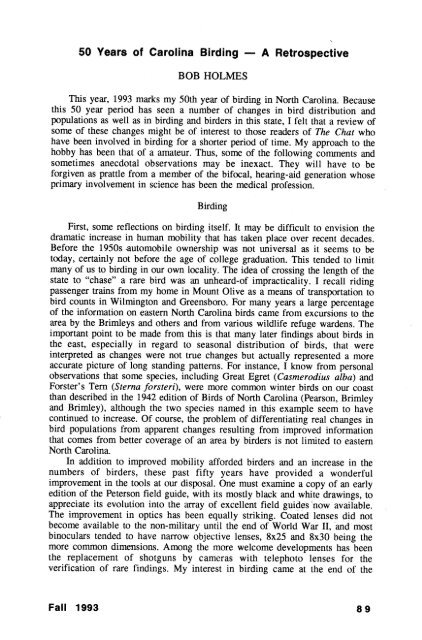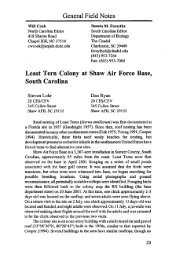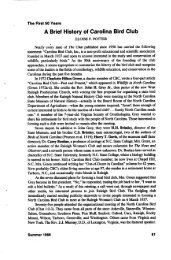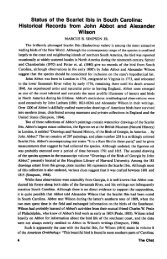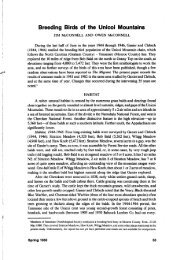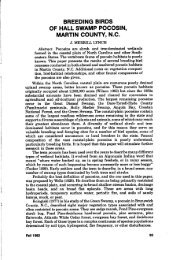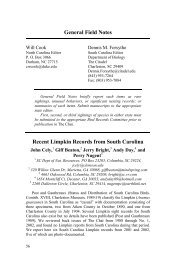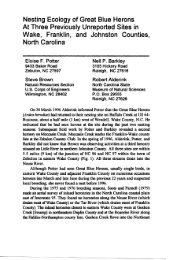50 Years of Carolina Birding - The Carolina Bird Club
50 Years of Carolina Birding - The Carolina Bird Club
50 Years of Carolina Birding - The Carolina Bird Club
Create successful ePaper yourself
Turn your PDF publications into a flip-book with our unique Google optimized e-Paper software.
<strong>50</strong> <strong>Years</strong> <strong>of</strong> <strong>Carolina</strong> <strong><strong>Bird</strong>ing</strong> — A RetrospectiveBOB HOLMESThis year, 1993 marks my <strong>50</strong>th year <strong>of</strong> birding in North <strong>Carolina</strong>. Becausethis <strong>50</strong> year period has seen a number <strong>of</strong> changes in bird distribution andpopulations as well as in birding and birders in this state, I felt that a review <strong>of</strong>some <strong>of</strong> these changes might be <strong>of</strong> interest to those readers <strong>of</strong> <strong>The</strong> Chat whohave been involved in birding for a shorter period <strong>of</strong> time. My approach to thehobby has been that <strong>of</strong> a amateur. Thus, some <strong>of</strong> the following comments andsometimes anecdotal observations may be inexact. <strong>The</strong>y will have to beforgiven as prattle from a member <strong>of</strong> the bifocal, hearing-aid generation whoseprimary involvement in science has been the medical pr<strong>of</strong>ession.<strong><strong>Bird</strong>ing</strong>First, some reflections on birding itself. It may be difficult to envision thedramatic increase in human mobility that has taken place over recent decades.Before the 19<strong>50</strong>s automobile ownership was not universal as it seems to betoday, certainly not before the age <strong>of</strong> college graduation. This tended to limitmany <strong>of</strong> us to birding in our own locality. <strong>The</strong> idea <strong>of</strong> crossing the length <strong>of</strong> thestate to "chase" a rare bird was an unheard-<strong>of</strong> impracticality. I recall ridingpassenger trains from my home in Mount Olive as a means <strong>of</strong> transportation tobird counts in Wilmington and Greensboro. For many years a large percentage<strong>of</strong> the information on eastern North <strong>Carolina</strong> birds came from excursions to thearea by the Brimleys and others and from various wildlife refuge wardens. <strong>The</strong>important point to be made from this is that many later findings about birds inthe east, especially in regard to seasonal distribution <strong>of</strong> birds, that wereinterpreted as changes were not true changes but actually represented a moreaccurate picture <strong>of</strong> long standing patterns. For instance, I know from personalobservations that some species, including Great Egret (Casmerodius alba) andForster's Tern (Sterna forsteri), were more common winter birds on our coastthan described in the 1942 edition <strong>of</strong> <strong>Bird</strong>s <strong>of</strong> North <strong>Carolina</strong> (Pearson, Brimleyand Brimley), although the two species named in this example seem to havecontinued to increase. Of course, the problem <strong>of</strong> differentiating real changes inbird populations from apparent changes resulting from improved informationthat comes from better coverage <strong>of</strong> an area by birders is not limited to easternNorth <strong>Carolina</strong>.In addition to improved mobility afforded birders and an increase in thenumbers <strong>of</strong> birders, these past fifty years have provided a wonderfulimprovement in the tools at our disposal. One must examine a copy <strong>of</strong> an earlyedition <strong>of</strong> the Peterson field guide, with its mostly black and white drawings, toappreciate its evolution into the array <strong>of</strong> excellent field guides now available.<strong>The</strong> improvement in optics has been equally striking. Coated lenses did notbecome available to the non-military until the end <strong>of</strong> World War II, and mostbinoculars tended to have narrow objective lenses, 8x25 and 8x30 being themore common dimensions. Among the more welcome developments has beenthe replacement <strong>of</strong> shotguns by cameras with telephoto lenses for theverification <strong>of</strong> rare findings. My interest in birding came at the end <strong>of</strong> theFall 1993 8 9
shotgun era, and many <strong>of</strong> us were adept at making study skins <strong>of</strong> collectedbirds.I do not recall when I first saw my first spotting scope, but I do know thatfor some time I was the only one in my group <strong>of</strong> birding friends who had atelescope <strong>of</strong> any description. It was an old brass pull-out type. To support andsteady the telescope I trimmed and carried a hardwood sapling about six feetlong with a fork at its tip, in which I couched the scope after sticking the end<strong>of</strong> this monopod into the ground. It pivoted about as well as modern tripods,was much lighter, was less expensive and doubled as a deterrer to theoccasional dog that challenged this suspicious person.Taxonomic ChangesAnother change I might touch on is the lumping and splitting <strong>of</strong> variousspecies <strong>of</strong> birds. A review <strong>of</strong> this subject would be too involved for this writing.I will mention just two examples. Formerly, the "Myrtle Warbler" (Dendroicacoronata), which has been renamed Yellow-rumped Warbler, was separatedfrom "Audubon's Warbler" (Dendroica auduboni). <strong>The</strong> Alder Flycatcher(Empidonax trailli trailli) has been split into Willow Flycatcher (Empidonaxtrailli) and Alder Flycatcher (Empidonax alnorum). Somehow I would still liketo think <strong>of</strong> the "Ipswich Sparrow" as a separate species rather than as a subspecies<strong>of</strong> the Savannah Sparrow (Passerculus sandwichensis).<strong>The</strong>n there's the matter <strong>of</strong> changes in the common names <strong>of</strong> variousspecies. I am afraid that for me a Whimbrel (Numenius phaeopus) will alwaysbe a Hudsonian Curlew, a Tundra Swan (Cygnus columbianus) always aWhistling Swan, and a Magnificent Frigatebird (Fregata magnificens) always aMan-o'-War-bird. Happily, the pendulum has been known to swing as in thecase <strong>of</strong> the Bachman's Sparrow (Aimophila aestivalis) which was transientlycalled "Pinewoods Sparrow". One does not have to be a taxonomist to agreewith the indication for such long overdue changes as from "Wood Ibis" toWood Stork (Mycteria americana).Changes in Distribution and NumbersNow to proceed with mentioning some <strong>of</strong> the more dramatic shifts in birddistribution and changes in abundance that have taken place within the pasthalf century. Certainly, no new ornithological observations will appear here.But, again, I hope to touch on some <strong>of</strong> the highlights that may not beappreciated by those who have been birding in North <strong>Carolina</strong> for a shorterperiod <strong>of</strong> time and to further impress upon others the dynamic status <strong>of</strong> birdpopulations and distributions. <strong>The</strong> recent surge <strong>of</strong> interest in pelagic birds hasproduced a pr<strong>of</strong>usion <strong>of</strong> new data; but the data were scant on these birds(especially the families Procellariidae and Hydrobatidae) in the <strong>Carolina</strong><strong>of</strong>fshore waters prior to about fifteen years ago. It would be presumptuous to saythat the expansion <strong>of</strong> our knowledge regarding the distribution <strong>of</strong> these speciesreflects any actual change.<strong>The</strong> most dramatic saga <strong>of</strong> this era, and one familiar to each <strong>of</strong> us, is thatwhich we might speak <strong>of</strong> as the ebb and flow <strong>of</strong> the "DDT birds", particularlythe Brown Pelican (Pelicanus occidentalis), the Osprey (Pandion haliaetus),9 0 <strong>The</strong> Chat Vol. 57
the Bald Eagle (Haliaetus leucocephalus), and the Peregrine Falcon (Falcoperegrinus). Of these, it is my impression that the Brown Pelican's rebound hasbeen the most striking and the Peregrine's the least so. Before DDT, winteringBald Eagles could be found readily almost anywhere along the coast. I have nomemory <strong>of</strong> the Peregrine Falcons having ever been common here in the firstplace.Although bird protection laws existed much earlier than <strong>50</strong> years ago, thefull resurgence <strong>of</strong> the terns and wading birds, following their decimation by themillinery trade, was still underway at least through the fifties. <strong>The</strong> stories <strong>of</strong> theGlossy Ibis (Plegadis falcinellus) and the White Ibis (Eudocimus albus) are abit more complicated in that these species have shown a true northwardextension <strong>of</strong> their breeding ranges since the mid-fifties, along with increases(transiently?) in their overall numbers.How many generations into the future will it be before we again witness atwo-continent range extension without the assistance <strong>of</strong> Man, as in the case <strong>of</strong>the Cattle Egret (Bubulcus ibis), which found its way to North <strong>Carolina</strong> in1956?On the less happy side is the alarming diminution in numbers <strong>of</strong>Anseriformes, including the fairly recent precipitous decrease in the population<strong>of</strong> migratory Canada Geese (Branta canadensis) in eastern North <strong>Carolina</strong>. <strong>The</strong>Wood Duck (Aix sponsa) responding to habitat improvement and legalprotection, represents a shining exception to this sorry picture.<strong>The</strong> Great Cormorant (Phalacrocorax carbo), formerly rare in the<strong>Carolina</strong>s, has become a regular winter resident along the entire length <strong>of</strong> thecoast beginning in the 1980s and is increasing in numbers. <strong>The</strong> winterpopulation <strong>of</strong> Double-crested Cormorants (Phalacrocorax auritus) continues toincrease, with flocks numbering in the thousands now being a common sightalong the coast. In addition, this species is now being reported frequentlyduring both winter and summer in the Piedmont and is even being seen in themountains. <strong>The</strong>re are now breeding reports <strong>of</strong> Double-crested Cormorants fromJordan Lake.Several gull species have undergone striking seasonal and populationalchanges. <strong>The</strong> Great Black-backed Gull (Larus marinus) was a winter OuterBanks specialty until it began expanding its range in the early 19<strong>50</strong>s. By 1973,it had become a breeding bird in North <strong>Carolina</strong>, and now may be foundregularly year-round in the lower portions <strong>of</strong> the larger rivers as well as alongthe coast, where its winter population increase has been explosive. <strong>The</strong>re arenow scattered reports <strong>of</strong> this species in the Piedmont. Within the past ten yearsthe Lesser Black-backed Gull (Larus fuscus) has become a regular winterspecies, at least along the Dare County coast, before which time it wasconsidered very rare. Herring Gulls (Larus argentatus) were not known to nestin North <strong>Carolina</strong> until 1962. Over recent years its numbers, and to an evengreater extent the numbers <strong>of</strong> Ring-billed Gulls (Larus delawarensis), havemarkedly increased—especially during the winter months. Also impressive hasbeen the westward extension <strong>of</strong> thee two species within the <strong>Carolina</strong>s.<strong>The</strong>re was what appeared to be an extension <strong>of</strong> the breeding range <strong>of</strong> theCommon Ground-Dove (Columbina passerina) as far north as Carteret Countyduring the 1970s. Since that time, the species has again become rare insoutheastern North <strong>Carolina</strong>.Fall 1993 9 1
<strong>The</strong> Whip-poor-will (Caprimulgus vociferus), formerly not known to breedeast <strong>of</strong> the inner coastal plains, is now being found as a breeder in the pineplantations as far east as the Croatan Forest. Another caprimulgid, theCommon Nighthawk (Chordeiles minor) has shown a progressive decrease innumbers, at least in eastern North <strong>Carolina</strong>.<strong>The</strong> plight <strong>of</strong> the Red-cockaded Woodpecker (Picoides borealis) has had aplace on center stage; but numbers <strong>of</strong> the Red-headed Woodpecker(Melanerpes erythrocephalus) have also decreased, this being especiallyapparent in the wintering population. Conversely, the adaptability andimproving status <strong>of</strong> the Pileated Woodpecker (Dryocopus pileatus) has been apleasure to witness.In 1952 I saw my first Barn Swallow (Hirundo rustica) nest—at CapeLookout. Prior to that time the species was known only as a very commonmigrant. Since the fifties their breeding range has extended centrally from boththe east and west to include the Piedmont and Coastal Plains <strong>of</strong> the <strong>Carolina</strong>s.<strong>The</strong> Bewick's Wren (Thryomanes bewickii) seems to have vanished fromthe <strong>Carolina</strong>s. From my reading I get the feeling that this range shrinkage wasalready underway more than fifty years ago. Over a more recent period <strong>of</strong> time,the breeding range <strong>of</strong> the House Wren (Troglodytes aedon) has extendedsoutheastward to include the entire Coastal Plain <strong>of</strong> North <strong>Carolina</strong>.<strong>The</strong> well recognized decrease in Loggerhead Shrikes (Lanius ludovicianus)seems to have been most drastic in the early 1980s.Almost across the board decreases in the numbers <strong>of</strong> neotropical migrantsis one <strong>of</strong> the stories <strong>of</strong> the hour, and unfortunately, is not a problem peculiar tothe <strong>Carolina</strong>s. This development is too complicated to be detailed in thisspace. Among this group <strong>of</strong> birds, the most intriguing history is that <strong>of</strong> theBachman's Warbler (Vermivora bachmanii), which was rediscovered nearCharleston during the late 1940s only to disappear once more. I suspect theexplanation <strong>of</strong> its fate is multifactoral. Northern Orioles (Icterus galbula) werechiefly known as migrants east <strong>of</strong> the mountains, but have become regularwintering birds since the late 1940s and occasional breeders since the 19<strong>50</strong>s.Blue Grosbeaks (Guiraca caerulea) seem be have become more common; butPainted Buntings (Passerina ciris) are more difficult to find now, in contrast toperhaps 25 years ago. This condition is undoubtedly related to increasingdevelopment <strong>of</strong> their coastal habitat.<strong>The</strong>se fifty years have seen an amazing increase in the numbers <strong>of</strong>Common Grackles (Quiscalus quiscula) regardless <strong>of</strong> the season. Fortunately,we no longer have to expend any effort to determine whether we are seeing a"Purple Grackle" versus and "Bronzed Grackle" versus a "Florida Grackle" aswe once did.House Sparrows (Passer domesticus), formerly a prominent part <strong>of</strong> theavifauna <strong>of</strong> every yard and small town street, are now much less common. Isuspect there are reasons for this change in addition to the decreasedavailability <strong>of</strong> horse manure and the incursion <strong>of</strong> House Finches (Carpodacusmexicanus) which have been postulated as explanations.A "finch year", in which we see unusually large numbers <strong>of</strong> finchescoming south, may be a phenomenon <strong>of</strong> the past. It was not until the early19<strong>50</strong>s, however, that these winter emigrations included large numbers <strong>of</strong>Evening Grosbeaks (Coccothraustes vespertinus).9 2 <strong>The</strong> Chat Vol. 57
<strong><strong>Bird</strong>ing</strong> PersonalitiesIn conclusion I would like to mention four birders from this era whodeserve special recognition. Perhaps there are others who are equallynoteworthy, but these are four people I am privileged to have known personally.First, C.S. Brimley. Although we remember Mr. C.S. as an ornithologist orbirder, the scope <strong>of</strong> his knowledge <strong>of</strong> natural history in general was impressive.He was a s<strong>of</strong>t-spoken gentleman who was able to tolerate and encourage anovice birder and, on the other hand, had little patience with reports heconsidered unreliable—to the extent <strong>of</strong> once completely disqualifying aChristmas Count that he felt contained too many highly unlikely species <strong>of</strong>birds. His response to questions was prompt and thoughtful, always in the form<strong>of</strong> handwritten postal cards. He was the oracle.A similar person, <strong>of</strong> a bit later vintage, was E.B. Chamberlain. Mr.Chamberlain was a reserved but warm individual with a great sense <strong>of</strong> humor,all <strong>of</strong> which tended to conceal his depth <strong>of</strong> knowledge in various areas <strong>of</strong>natural history in general as well as <strong>of</strong> birds in particular. His contributions tobirding in the <strong>Carolina</strong>s went far beyond his having co-authored South <strong>Carolina</strong><strong>Bird</strong> Life.<strong>The</strong> third person I shall name is the other co-author <strong>of</strong> South <strong>Carolina</strong> <strong>Bird</strong>Life, Alex Sprunt, Jr. Not only was Mr. Sprunt known for his writing and hiswork with the National Audubon Society, but also he was especiallyimpressive in the field identification <strong>of</strong> birds. He was a young birder's idol,whom I <strong>of</strong>ten thought <strong>of</strong> as our southern Ludlow Griscom.Finally, there was Edna L. Appleberry, who, though quite different from theabove personalities, deserves special mention when one thinks <strong>of</strong> those whocontributed to <strong>Carolina</strong> birding from the 1940s to the 1960s. Mrs Appleberrynever pretended to be an ornithologist or even an eminent birder. She was,however, the equivalent <strong>of</strong> a one-person ornithological chamber <strong>of</strong> commercefor southeastern North <strong>Carolina</strong>. It was partly due to her effort that a greatlyimproved knowledge and appreciation <strong>of</strong> birds in this area has come about.Mrs. Appleberry and her wonderfully tolerant husband, Cecil, are alsoremembered for having helped and encouraged a number <strong>of</strong> youths who arenow outstanding birders.Certainly the next fifty years <strong>of</strong> <strong>Carolina</strong> birding will produce as manyinteresting developments and changes as have the last fifty. <strong>The</strong>re will surelybe as many challenges for the birds and the birders. I do hope that the batonbeing passed to the new generation <strong>of</strong> birders will carry with it the immensepleasure that birding has afforded me and my generation.Appreciation is expressed to John Fussell for his review <strong>of</strong> this paper. Anyerrors, however, are attributable to the author.4003 Trent Pines Drive, New Bern, NC 28862Fall 1993 9 3


